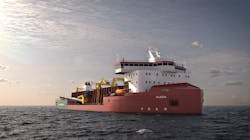US offshore wind’s new vessel opportunities
Editor's note: This story first appeared in the 2023 Offshore Wind Special Report, which published within the September/October 2023 issue of Offshore magazine.
By Wei Huang, American Bureau of Shipping (ABS)
US offshore wind development is essential to help meet the US administration's decarbonization goals, and its construction and development requires specialized offshore vessels to support its growth.
A critical underpinning of the US offshore wind market is a state's own policy framework, which is needed to guide goals backed by power purchase agreements to drive investment. The Jones Act requires cargo delivered between US points and ports to be transported by ships that are US-owned, built and crewed. While companies can bring in construction vessels from Europe, they can't transport cargos between ports, so smaller support vessels are needed to enable the transfer of cargo from port to project site for a developer.
Several risk profiles are evolving across the sector’s supply chain. This includes the need to ramp up the delivery of support vessels, through to the challenges around the physical manufacture of vessel newbuilds, engineering standards and regulations, workforce and skilled labor, supply chain interruptions, and port access, upgrades and its developing infrastructure for the long term.
The range of vessels used during an offshore wind farm life cycle is extensive. According to ABS and others, this US offshore wind build-out will require more than 110 US vessels to meet 30 GW by 2030. These vessels identified in various phases include:
| Survey and dredging: | Survey vessels; dredgers |
| Foundation installation: | Monopiles and jackets installed by a jackup vessel or self-propelled wind turbine installation vessel (WTIV); crane barges |
| Turbine installation: | WTIVs and jackup vessels; crane barges and heavy-lift vessels |
| Transportation/feeder: | Supply and heavy-transport vessels; lifeboats and feeder jackups; feeder barges; crew transfer vessels (CTV) |
| Cable laying: | Cable-laying vessels; cable-laying barges |
| Operation and maintenance: | Heavy maintenance vessels; service operation vessels (SOV); CTVs |
Getting offshore wind projects completed on time is another part of the puzzle. Bottlenecks can easily slow down the development process for an already lengthy project timeline (averaging about seven to eight years for an offshore wind project to become operational), and the Bureau of Ocean Energy Management recently addressed this with a new process after the notice of intent was awarded. But getting projects delivered on time and to budget is a driver for the profitability during construction, and projects will soon be competing for resources in the supply chain. For first-time projects from a developer, ABS recommends that identifying risks early can help address and raise awareness with regulatory and enforcement agencies to support the safety focus and growth of the US wind supply chain.
Collaboration is critical
As the industry moves toward the ambitious 2030 offshore wind target, ABS is working with customers together across states, organizations and supply chains to enable opportunities to collaborate and innovate for a better future. A recently formed working group and collaborative network has been created for the offshore wind sector by ABS that addresses both the regulatory complexities, vessel needs, class rules and safety challenges to support a smooth process in the development of future offshore wind farm developments in US waters.
The working group consists of industry leaders, partners, non-federal stakeholders, developers, designers, owners, vessel charterers, shipyards and more than seven of the US Coast Guard bodies. ABS is engaging with these stakeholders to help support and promote best practices for safety and environmental protection, which contributes into the wider nation’s renewable energy program functions.
As US offshore wind projects move through the development phase, market participants and experts can discuss in the working group some of the challenges that are being worked through, like standards and regulations, design and construction risks. Initially, the working group will collectively seek to clarify and enhance CTV requirements for class and US operations based on the way in which vessels operate offshore.
Advancing offshore wind
New developments are expanding opportunities. A Jones Act-compliant subsea rock installation vessel, the first such ship to enter the US market, is to be built to ABS class by Philly Shipyard Inc. for the Great Lakes Dredge & Dock Co. LLC. The vessel will transport and strategically deposit loads of up to 20,000 MT of rock on the seabed, laying scour protection for offshore wind farm foundations, cables and other structures. It will be awarded the ABS SUSTAIN-2 Notation, recognizing adherence to certain UN Sustainable Development Goals related to vessel design, outfitting and layout.
Currently, there are only three Jones Act CTVs in operation in the US, including Atlantic Wind Transfers’ Atlantic Pioneer and Atlantic Endeavor and WindServe Marine’s WindServe Odyssey. Ten more CTVs were awarded to ABS class, five to WindServe under construction at Senesco Marine and five to American Offshore Service, with two being built at Blount Boats and three at Metal Shark.
More CTV orders are anticipated for the specific tenders put out by the wind farm developers as the US ramps up its contribution toward the global offshore wind industry’s ambition to reach 560 GW by 2040. There are two WTIVs and three SOVs under construction for the US market.
